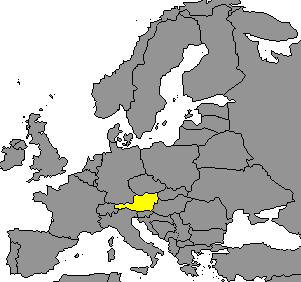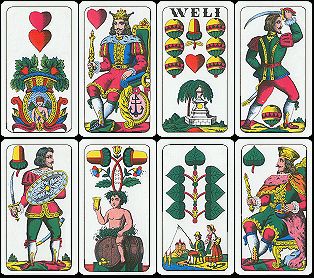The cards used for Austrian traditional games are the same "Four Seasons" (or Tell)
decks used in the Czech Republic and in Hungary, a pattern locally known as Doppeldeutsche ("double German").
But Austrian editions also include a peculiar subject called the WELI,
which is usually not found in the aforesaid countries. The card is the 6 of
Bells: it features this word in black letters, but it also shows the Acorns and Hearts suit sign:
in certain games the WELI acts as a joker. In fact, fewer editions
have 33 cards, made of four suits with eight cards each (7 to 10, plus the three
courts and the daus, like a Skat deck), and the WELI as
a further additional card. |
 |

Doppeldeutsche deck (by Piatnik, Austria) |
In Austrian packs the names of the seasons are often spelled above the central picture,
obviously in German. Also ober and under knaves bear the names of
characters from the play "Wilhelm Tell", while the four mounted Kings are nameless.
Besides the Doppeldeutsche, there is another German-suited deck used in the west
of the country (Tyrol): the Einfachdeutsch pattern, even more popular
in the southern half of this region, which belongs to Italy, and is therefore printed by
Italian manufacturers, as well, with the name Salzburger or Salisburghesi.
|
|
The Einfachdeutsch pattern
has single-ended subjects (the Austrian name of the pack actually means "Single German"), and
has a graphic relation with the Bavarian pattern, though it always
contains a WELI card as the Doppeldeutsche pack.
The Italian-made version, called Salzburger, once consisted of 36 cards, as the original Autrian one, but now all national manufacturers produce it as a 40-card pack, adding 5s to the series of pip cards.
Austrian playing cards are not only German-suited: two more patterns with French suits
are used in this country, known as Wien - I and Wien - II, or Austrian Large Crown and Austrian Small Crown.
|

Salzburger deck (by Modiano, Italy); no indices
are shown; note the WELI in both Austrian patterns |

Viennese large crown pattern, by Piatnik (Austria) |
The first of the two is also used in the Czech Republic, and is described in the central european gallery, as well. The courts are double-headed, featuring personages whose base is rather large, and slightly exceeds the frame on both sides, as well as in the upper part; the knaves and the kings are shaven, except the knave of Spades, wearing a moustache. The most easily recognizable personage is the knave of Hearts, who holds a flag bearing the name WIEN, or a reference to the manufacturer (whose name can be read on the band worn by the king of Spades). |
There are no indices, and the courts feature their own suit sign in the corner, but without a letter; the aces, instead, have four small suit signs, located in each corner.
The Viennese large crown pattern is found in different compositions: the most common one is the 32 card-version, for the game of Preference (Germany) and Picket (Austria, Czech Republic, north-eastern Italy), but in Austria also a 24-card version for the game of Schnaps and the less common 52-card version exist.
Also the second pattern ("small crown") has double-headed courts, closer to the ones belonging to ordinary international decks, but more finely ornate than the latter; their size is slightly smaller than the large crown pattern. |

Viennese small crown pattern, by Modiano (Italia) |

Rhineland pattern, by Piatnik |
In this case the kings' crowns do not reach the frame. The court indices are the standard ones, and so are the pip cards, including the aces. They are available in 32-card and 52-card versions.
Finally, one more variety is the Rhineland pattern, whose origin is German, see the relevant gallery, but is now used only in other European countries, including Austria. Piatnik's edition (left) is a 52-card deck, with very brightly coloured courts; the line that encircles them forms four small recesses in the corners, in which the indices are fit. |